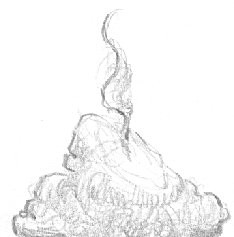A team of investigators headed by Southwest Research Institute
(SwRI) has identified the cause of a long-standing jet fuel
contamination problem.
 SwRI
scientists traced the dark, gelatinous material, frequently called
"apple jelly," to an anti-icing additive that becomes a potent
solvent when mixed with water.
SwRI
scientists traced the dark, gelatinous material, frequently called
"apple jelly," to an anti-icing additive that becomes a potent
solvent when mixed with water.
The military, particularly the U.S. Air Force, has struggled
with jelly-like contaminants in fuel-handling systems for almost 50
years. Despite studies to isolate its cause, the problem has
persisted, becoming a maintenance nightmare. Although the substance
has been found in aircraft wing tanks, it is not believed to have
caused any engine failure or crashes.
In 2001, the Defense Energy Support Center (DESC), the federal
agency responsible for procuring and distributing fuel to the
Department of Defense, asked SwRI to determine what apple jelly
was, how it forms, and how it can be prevented or reduced.
After a year-long study, Institute scientists determined that
apple jelly is caused by diethylene glycol methyl ether (DiEGME)
interacting with water and other fuel system contaminants. DiEGME,
an anti-icing inhibitor added to JP-8 jet fuel, prevents free water
in a plane's fuel system from freezing at high altitudes. SwRI
demonstrated that apple jelly is a complex mixture with varying
viscosity, color, and other properties.
The term probably dates to the middle 1980s when a presentation
to a subcommittee of the American Standards of Testing and
Materials referred to a contaminant found in the Alberta Products
Pipeline (APPL) as "APPL jelly." Since that time, the name has
evolved to apple jelly and has been applied to a range of
contaminants found in aviation fuel-delivery systems.
 "After DiEGME joins with water, it forms a very
aggressive solvent," explained Program Manager Steve Westbrook,
manager of the Petroleum Products Technology section in SwRI's
Engine and Vehicle Research Division. "When added to the fuel,
DiEGME combines with free water and then reacts with dirt, rust,
paint, fuel components, elastomers, and other contaminants in
pipelines and fuel storage tanks. The resulting DiEGME-based
mixture, with varying viscosity, color, texture, and appearance, is
frequently identified as 'apple jelly.'
"After DiEGME joins with water, it forms a very
aggressive solvent," explained Program Manager Steve Westbrook,
manager of the Petroleum Products Technology section in SwRI's
Engine and Vehicle Research Division. "When added to the fuel,
DiEGME combines with free water and then reacts with dirt, rust,
paint, fuel components, elastomers, and other contaminants in
pipelines and fuel storage tanks. The resulting DiEGME-based
mixture, with varying viscosity, color, texture, and appearance, is
frequently identified as 'apple jelly.'
 "When
this blend reacts with polyacrylate polymers used to manufacture
water-absorbing fuel filters used in some military fuel-handling
systems, it forms the thick, gooey, sticky substance known as
'thick apple jelly.'"
"When
this blend reacts with polyacrylate polymers used to manufacture
water-absorbing fuel filters used in some military fuel-handling
systems, it forms the thick, gooey, sticky substance known as
'thick apple jelly.'"
SwRI headed a team that included Consulting for Energy
Efficiency and Environmental Excellence (C4e) and Martin &
Associates. The team conducted 31 onsite military base visits and
examined 139 samples of apple jelly, fuel, and other types of
samples related to apple jelly contamination.
To help prevent the contamination, SwRI recommended improved
fuel-handling procedures and facilities designed to remove water
from the fuel-distribution system and to ensure proper mixing of
additives in the fuel.
 ANN's Daily Aero-Term (04.20.24): Light Gun
ANN's Daily Aero-Term (04.20.24): Light Gun Aero-News: Quote of the Day (04.20.24)
Aero-News: Quote of the Day (04.20.24) ANN's Daily Aero-Linx (04.21.24)
ANN's Daily Aero-Linx (04.21.24) Aero-News: Quote of the Day (04.21.24)
Aero-News: Quote of the Day (04.21.24) ANN's Daily Aero-Term (04.21.24): Aircraft Conflict
ANN's Daily Aero-Term (04.21.24): Aircraft Conflict





